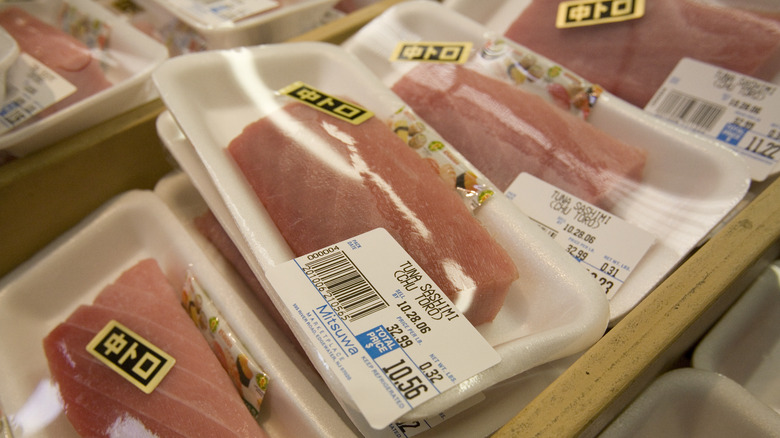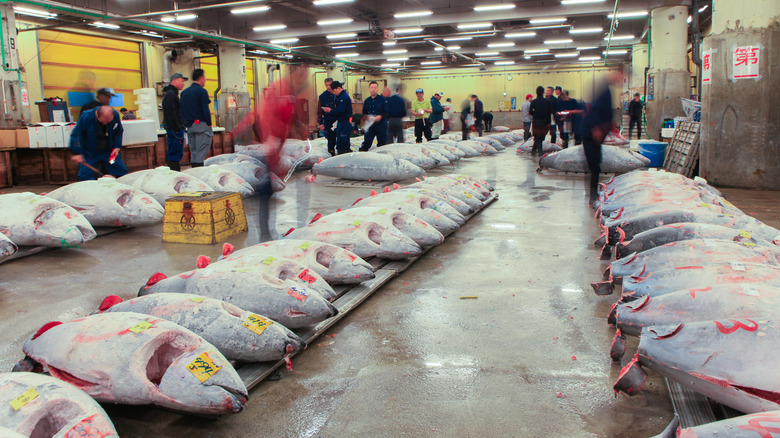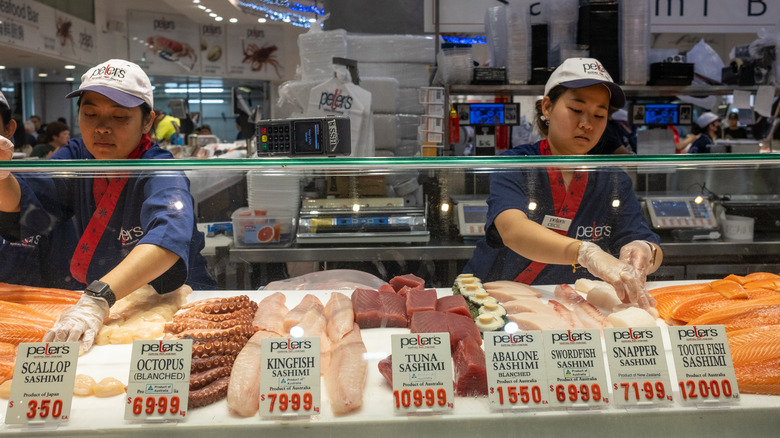What Does Sushi-Grade Really Mean When It Comes To Fish?
There's an undeniable magic to a delicious bite of sushi. Whether it's the meaty delight of fresh tuna, or the melt-in-your-mouth nature of fatty salmon, raw fish impresses. Yet, especially for newcomers, it can be hard to shake the fear of sampling the food without cooking. After all, the idea of a parasite in the flesh — with its off-putting worm-like form — is enough to function as a deterrent. Thankfully, no need to worry; there are precautions in place. You've likely seen the sushi-grade label at the store, a sign it's not a complete gamble regarding what's good to eat.
You may have wondered what this delineation really means. What fish is fit for sushi grade, and how is the label enforced? Well, turns out it's a bit of a complicated question. Unfortunately, in the U.S. and countries like the U.K., the term is not regulated by a governing body, and started for marketing purposes. Unlike beef, no federal workers are inspecting distributed fish cuts, and verifying what grades are good to serve raw.
Instead, it places the trust on the fish seller or restaurant supplier. These industries do follow guidelines, with practices of sanitation, freezing, and careful species selection, so raw fish is not a food you should reconsider ordering from a sushi restaurant. However, especially when you're shopping for such fish yourself, it's worth knowing the specifics of the sushi-grade label.
Sushi grade fish varieties are typically deep frozen
First of all, not every type of fish can be sushi to begin with. Freshwater fish is completely avoided, as it's deemed especially likely to possess a parasite. The same applies to cod, which may carry a specific variety of cod worm. Large tuna varieties are considered safer, although be more cautious with the tuna scrape in your sushi. Additionally, salmon gets extra scrutiny, especially since it spends part of its life cycle in freshwater. For this reason, farmed salmon is preferred, and the fish is nearly always frozen beforehand
In fact, cooling fish to super low temperatures has become a prominent component of the sushi-grade label for all varieties. The U.S. Food and Drug Administration does offer recommendations for raw fish consumption, with flash-freezing being a central tenet. They have three strategies, which all encompass low temperatures, like −4 degrees Fahrenheit kept for a week or a −31 degrees Fahrenheit deep-freeze for under a day. Certain states do enforce such parameters legally.
Cold storage is essential to stopping bacteria, a precaution essential for any fishmonger, and such a deep-freezing protocol also aids in eliminating parasites, making it especially useful for sushi. Additionally, flash-freezing with modern technology can preserve the freshness of the fish. The result is that, over the past few decades, this process has become interlinked with the sushi grade label, and is commonly employed in Japan.
Keep an eye on the details when buying sushi grade fish
Although the deep freeze certainly helps, there are some additional specifics to sushi-grade fish, too. Much of the handling happens out of the consumer's sight, so it's good to know what to look for. It all starts fresh out of the water — fish meant for sushi is caught in a unique way. The guts and blood are disposed of quickly, and the animal must be cooled quickly to stop the spread of parasites. In fact, it's important to keep sushi-grade fish in a cold environment during its entire distribution process.
As a result, make sure to inspect the conditions of your sushi fish purveyor. Examine the amount of ice, look for ample separation between fish types and impeccable sanitation standards. The smell is another giveaway — the air should give pleasant notes of the ocean. It's even better if you purchase whole fish, both to minimize cross-contamination and look for a few further signs, like clear eyes and red gills. All raw fish should be firm to the touch, with a vibrant color. Examining these criteria can showcase more than only the label, and it never hurts to ask your fishmonger, too — while it is possible to buy sushi-grade salmon at Costco, there's always added benefit to going to a smaller business. While you can never be 100% sure, with a reputable seller, the odds are not worth stressing over.


